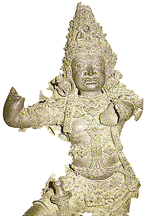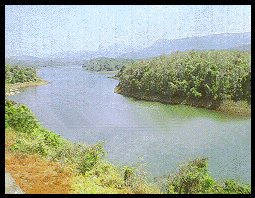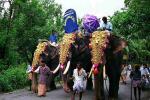On entering the temple, one is faced with elegant architectural style that is unique to Kerala. The temples of Kerala are not imposing in appearance like all other South Indian temples which have towering gopurams. The comparatively low, tiled roofs and the liberal use of wood harmonize with the natural environment.
Left to the entrance is Koothambalam or theatre hall, a remarkably beautiful structure with an elegant sloping roof of metal plates. Within this is staged the ancient dramatic art form of Chakyar Koothu.
 Within the main shrine resides Vadakkunathan or Lord Shiva, represented by a Mahalingam. This however cannot be seen because the traditional offerings or 'abhishekha' with cow's ghee over several decades, and in fact centuries, have formed a large 3-metre-mound around the lingam. Miraculously even the warm tropical climate of Kerala does not melt, or in any way spoil it. It is believed that a part of the ghee is as much as a thousand years old, and is in great demand by Ayurvedic doctors who require old ghee for their herbal preparations.
Within the main shrine resides Vadakkunathan or Lord Shiva, represented by a Mahalingam. This however cannot be seen because the traditional offerings or 'abhishekha' with cow's ghee over several decades, and in fact centuries, have formed a large 3-metre-mound around the lingam. Miraculously even the warm tropical climate of Kerala does not melt, or in any way spoil it. It is believed that a part of the ghee is as much as a thousand years old, and is in great demand by Ayurvedic doctors who require old ghee for their herbal preparations.
Trichur has several other popular temples including Paramekkavu Kshetram dedicated to Bhagwati or Durga and the Thiruvambadi Temple which is dedicated to Lord Krishna. This busy little town has a splendid Lourdes church with a large and imposing interior.
The State Museum and the zoo, both enclosed within the same area, are the other attractions of Trichur.
Around Trichur
 23 kms away from Trichur is the enchanting picnic spot, Peechy dam. Wild tuskers are seen on the forested banks of the wildlife sanctury.
23 kms away from Trichur is the enchanting picnic spot, Peechy dam. Wild tuskers are seen on the forested banks of the wildlife sanctury.
Tiruvilluamala shrine, Kerala's most important temple dedicated to Lord Rama, is 29 kms from Trichur. Another temple dedicated to Lord Rama, the Triprayar Temple is south of Trichur. It has exquisite wood carving and sculptures.
The only temple in India, dedicated to Lord Rama's brother, Bharata, is the Kutalmanikyam temple in Trichur district. The waters of this temple tank are said to have curative powers.
40 kms south-west of Trichur is Kodungalloor which has India's oldest mosque, Cheraman Jama Masjid. This place also has the ancient Shiva temple, Thiruvanchikulam kshetram and Kodungalloor Bhagawati kshetram.
The first Jewish settlement in India was in Kodungalloor (known as Cranganore, that time). St. Thomas the Apostle landed here in AD 52.
Kerala kalamandalam at Cheruthuruthy, the foremost institution imparting training in the classical arts like Kathakali, Koodiyattam and Mohiniattam, is situated on the main road from Trichur to Shoranur.
Guruvayur, known as the Dwaraka of the South is just 29 kms away from Trichur.
When to Visit
The famous Pooram festival (April/May), introduced by the Kochi (Cochin) Raja, Shaktan Tampuran (1789-1803), is celebrated all over Kerala. Thrissur Pooram is held on the Tekkinkadu maidan outside the Vadakkunnathan temple. The beautifully caparisoned elephants in two processions, representing the Tiruvambadi and Paramekkavu temples, compete to create the more impressive sights and sounds. They eventually meet, like armies on a battlefield, facing each other.
 Both sides present fifteen elephants decorated with gold ornaments, each ridden by three brahmins clutching objects symbolizing royalty: silver-handled whisks of yak hair, circular peacock feather fans and orange, green, red, purple, turquoise, black, gold or patterned silk umbrellas fringed with silver pendants. At the centre of each group, the principal elephant carries an image of the temple's deity. Swaying gently, the elephants stand still much of the time, ears flapping, while bomb-like firework bangs and the huge orchestra that plays in front of them.
Both sides present fifteen elephants decorated with gold ornaments, each ridden by three brahmins clutching objects symbolizing royalty: silver-handled whisks of yak hair, circular peacock feather fans and orange, green, red, purple, turquoise, black, gold or patterned silk umbrellas fringed with silver pendants. At the centre of each group, the principal elephant carries an image of the temple's deity. Swaying gently, the elephants stand still much of the time, ears flapping, while bomb-like firework bangs and the huge orchestra that plays in front of them.
Known as Chenda Melam, the quintessentially Kerala music, featuring as many as a hundred loud, hard-skinned, cylindrical chenda drums, crashing cymbals and wind instruments, mesmerizes the crowd while its structure marks the progress of the procession. The melam passes through four phases of tempo, each a double of the last, from a majestic dead slow through to a frenetic pace. The arrival of the fastest tempo is borne on a wave of aural and visual stimulation. Those astride the elephants stand at this point, to manipulate their feather fans and hair whisks in co-ordinated sequence while behind, unfurled umbrellas are twirled in flashes of dazzling colour and glinting silver in the sun.
All this is greeted by firework explosions and roars from the crowd.When the fastest speed is played out, the slowest tempo returns and the procession edges forward, the mahouts leading the elephants by the tusk. Stopping again, the whole cycle is repeated. At night, the Vadukannathan temple entrances are a blaze of coloured lights and a spectacular firework display takes place in the early hours of the morning.
Great Elephant March (9 to 12 January every year) is another colourful offering of Trichur.
Kandassamkadavu Boat Race is an annual feature of Trichur district coinciding with the Onam festival during August/ September.
How to Get There
By Air: Nearest airport Cochin is 74 kms away.
By Road: Kerala State Road Transport Corporation buses are available from all parts of Kerala.
By Rail: Nearest railway station is Trichur.
Where to Stay
Kerala Tourism Development Corporation's 'Yatri Nivas', Government Guest House, Hotel Elite International, Oriental State Hotel, Ambassador Hotel, Volga Tourist Home.